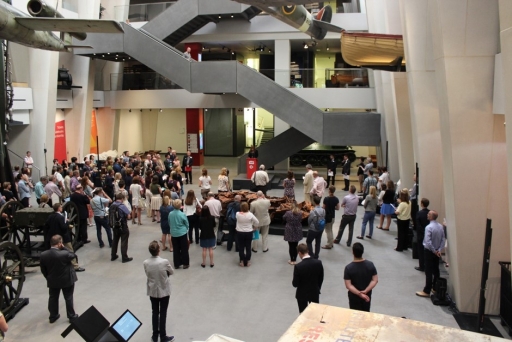Centenary News Editor Nigel Dacre attended the official opening of the Imperial War Museum’s new galleries on Wednesday 16th July – an event marked by speeches and interviews in the new IWM atrium. Here’s his account of the event.
It’s taken about 4 years to complete – as long as the First World War itself. But today the Imperial War Museum unveiled the refurbishment of its London museum to the press and media.
Museum staff, in speeches and interviews, were clearly proud of what had been achieved – although also just as clearly relieved that the refurbishment had been completed on time, with the new galleries opening to the public a few weeks before the anniversary of the outbreak of the war.
One member of staff told me of the sleepless nights that he’d been having in the run up to the opening, and another admitted that they had only just completed putting the finishing touches to the new layout in the week before the opening.
But in my view, IWM staff deserve to be really pleased with the outcome, and be justifiably proud of the work that they’ve done.
I must admit that I had a tinge of sadness as I walked in. The old museum ground floor layout, which I’d walked through so many times over the years, was no more.
But the new atrium, designed by Foster + Partners, with its terraced galleries, a Harrier and Spitfire hanging from the ceiling, and a V-1 rocket centre stage, is stunning.
There’s a Tardis-like feel to the space, as it seems a lot larger inside than seems possible from outside.
Speeches marking the media opening of the new IWM galleries. Photo: Centenary News
First World War Galleries
The First World Galleries themselves, just off the main atrium, have 1,300 objects – including weapons, uniforms, diaries, letters, maps, posters, films, audio clips, and a wide range of other items from the Museum’s vast First World War collection. The larger exhibits include a 9.2 inch howitzer gun, a Sopwith Camel fighter plane, and a Mark V tank.
There’s so much content, that it’s actually difficult to take it all in on the first walk through, and there’s certainly enough to justify coming back for repeat visits.
I was told that the new galleries were designed to be accessible to visitors who may not know a lot about the war, particularly the younger generation, but also to have enough depth to be of interest to those with a more detailed knowledge of the conflict.
Being able to appeal to both non-experts and experts is always difficult to pull off – and all credit to the Museum for doing just that.
The First World War galleries also successfully cover the home front as well as the battlefields, and makes good use of quotes and newspaper headlines from the period. Particularly impressive are the digital interactive graphics panels.
Inside the galleries, I spoke to Cambridge’s Professor David Reynolds, author of ‘The Long Shadow’ and IWM advisor. He accepted that there had been a lot of “academic debate” on the IWM advisory group about the development of the new galleries.
But he added: “We were always clear that we needed to acknowledge the familiar narrative about the trenches, the mud and the blood, but that we also had to open up other aspects of the war. So there’s a lot more about the home front than previously, and a lot more about global dimensions, including Britain’s allies.”
Exhibits in the new galleries. Photo: Centenary News
Tone
Outside the galleries, in the atrium, I spoke to the IWM Director-General Diane Lees about the refurbishment.
I asked her about the issue of tone, always contentious with the Centenary and the First World War, and the responsibility of being the main focus for how the country remembers and understands a war for which there is now no longer a ‘living memory’.
She said “I think we have got the tone right. The key to that was the decision to use contemporary quotes, and to use the voices of the people that were there.”
“But yes, it’s a huge responsibility, and the museum has taken that very seriously. In fact one of things about the redevelopment is that we very firmly went back to our founding mission – which is really about people. It’s not about military glory. It’s much more about the toil and sacrifice of ordinary people doing extraordinary things.”
I would agree with this. I think the IWM has struck the right tone with the new galleries. They are dramatic, but avoid glorifying violence or resorting to First World War clichés or generalisations.
The Trench
Any downsides?
Well, it’s a pity the Museum itself isn’t larger! The new galleries could probably have benefited from having more space.
And the trench, made of concrete, was obviously influenced by a ‘less is more’ designer – replacing the duckboards, rats, and sound effects of the old Trench Experience, with projected silhouettes of soldiers and other images.
It’s undeniably a more contemporary interpretation of the horror of the trenches – but, in my view, it lacks the impact of its predecessor.
But the trench aside, I think the refurbishment is a great success. The new IWM First World War galleries are intelligently presented, comprehensive, and packed with interesting content and exhibits.
The Imperial War Museum was founded in 1917 to ensure that Britain’s experience of the First World War would not be forgotten – and the galleries and atrium carry on that mission in a new and modern way.
Images: Centenary News Photos
Posted by: Editor, CN
